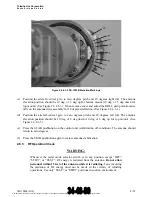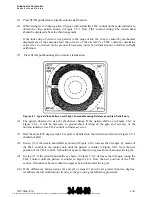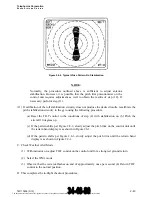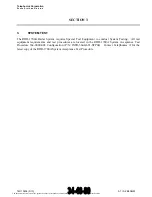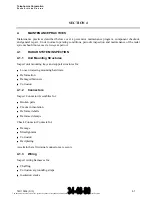
Telephonics Corporation
R
A D A R
S
Y S T E M S
D
I V I S I O N
2-32
TM113806 (3/10)
have a choke flange and a cover flange at its opposite ends, where possible. Carefully avoid
specifying nonstandard flanges, such as cover flanges with tapped screw holes.
Q
Axial twists in rigid waveguide, up to 90 degrees, should be considered as being made in
approximately an 8-inch length of waveguide. Before specifying twists in rigid waveguide, make
certain that the same result cannot be more easily accomplished by properly oriented bends in a
section of flexible waveguide.
The following points should be observed in the use of flexible waveguide components:
Q
Use standard flexible components wherever possible.
Q
Minimize the number of joints in the waveguide run.
Q
Locate a flexible section at the points of attachment to the antenna unit and the R-T unit. These
sections will provide expansion joints in positions where the installation or removal of rigid
waveguide would be exceedingly difficult.
Q
Flexible waveguide should be used, instead of rigid sections containing complex bends, wherever
possible. Compound bends and apparent twists can be obtained through the use of flexible
waveguide, usually at lower cost and with some simplification of installation.
Q
In any single installation, attempt to use the same length of flexible waveguide for all flexible
sections of the transmission line.
Q
Clamp flexible waveguide firmly to a solid portion of the aircraft structure at least once in each 18
inches of waveguide run.
Q
Design flexible waveguide clamps carefully so that they do not distort the waveguide walls.
Q
Use waveguide quick disconnects wherever joints are to be broken repeatedly or to ensure good
joint sealing in relatively inaccessible locations.
Q
Use flexible waveguide to produce the same effect as a twist in rigid waveguide components. Any
combination of two alternate (right and left) 90-degree bends in either the E or H plane (broad or
narrow wall) with any 90-degree bend in the opposite plane between them will produce an effective
waveguide twist. Such flexible components are less expensive and more easily installed than rigid
twists.
With an antenna connected to the waveguide installation, it may be desirable to test the entire
waveguide run including antenna for total VSWR. This must be done with the antenna pointing into
free space to avoid the possibility of reflective target interference. The total VSWR will be the result of
many factors in the waveguide and antenna. A long waveguide run may tend to increase the VSWR.
Therefore, a short run is more desirable.
Ratios as high as 2:1 have been experienced without noticeably disturbing the system operation;
however, a lower VSWR is desirable. Insertion loss is also increased with excessive waveguide length.
The suggested maximum waveguide length, including bends, should not exceed 10 feet for best
performance. See Waveguide specifications in Section 1.6.
The document reference is online, please check the correspondence between the online documentation and the printed version.




















